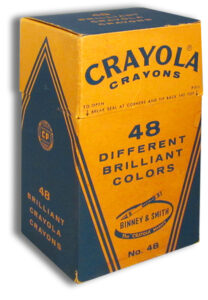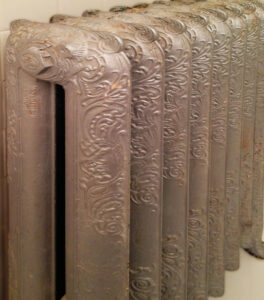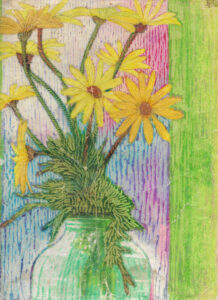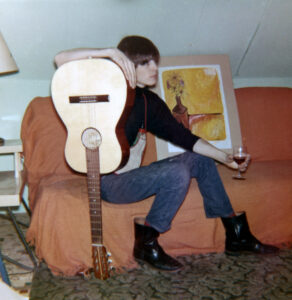Trapped behind a wall of ice for the sake of Art
As a young man and penniless like most young people then and now, art supplies were expensive and just out of reach. One had to be cautious and creative to find ways to create art. Never one to be held back by circumstances, I turned to what was cheap and available: Crayons.
Out of necessity, a technique developed using crayons to layer colors over one another and then scrape bits of layers away to create textures. But, basically, the art was crayon drawing taken to a new level.
The last step in the process was to coat the piece in white glue as a protective covering. This was tricky since glue is water-based, and crayon is wax-based. But it could be done, and the effect was very lovely and finished-looking. Plus, the wax drawing was protected. The technique drew a lot of attention, and someone set up an event where I would do a drawing as a demonstration, and people would pay to get in and watch. This was great for a destitute artist.

Crayola Crayons, Box of 48, circa 1966
The benefit of living in the remote culture of Anchorage, Alaska, in the mid-sixties, was that there were relatively few artists. This meant that any artist, by definition, had a better chance of selling or obtaining commissions. There was less competition.
With the proceeds from the demonstrations, a deposit was placed on a small storefront space on a back street. “Frailties Gallery” became my first gallery, a tiny, narrow storefront with a sink and a toilet in the back. Perfect for rough living and displaying. It had sound white walls, now covered with crayon drawings, unframed. Cooking was done on a hot plate, sleeping behind the partition at the back, on a mat on the floor.
The front of the store space had a large window. Under the window was an old-fashioned steam radiator that kept the small space comfortable. The front door was a sizeable wood-framed glass door. Condensation formed on the window and door glass when the radiator was on. Now and then, an art patron would open the door and come in, primarily out of boredom, so it seemed. Though the gallery was less than successful, it was a place where my girlfriend Mary and I could live. Best of all, I could use the phrase “my art gallery.”

Broken Crayons
The status of owning a gallery was an illusion. No sales meant taking a job at a gas station far out of town became necessary. The job started at 5 am. I pumped gas in the snow and returned to the gallery in the early afternoon. The story of the commute to and from the gas station in cold darkness on icy roads is epic in itself, but that can wait until another time. At 21 years old, one does what one must do. This routine went on for some time until the middle of the Alaskan winter.
Even in a lower latitude such as Anchorage, winters in Alaska are notoriously dark and cold. I must say, however, that the worst winters I have ever experienced were on the East Coast. Alaska has little humidity, and humidity is what carries cold and heat.

Antique Radiator
The radiator was pumping out heat all night but barely keeping the gallery warm because of the considerable exposure of glass. The slight heat there warmed the glass, causing condensation, in other words, humidity. This condensation rolled down the glass of the door and onto the floor just in front of the crack at the bottom of the door, where the outside air blew in steadily. That night, the frigid draft had been blowing in all night.
The condensation rolled down, and the draft froze the water in place on the floor. This had gone on all night so that by morning, there was a sloping wall of ice six or more inches thick blocking the door. The door was frozen shut.
Chipping away at it took a long time. I was late for my gas station job. There was no phone to call. It was important not to force the door too much because it was framed glass and could easily break. There was nothing to be done but wait and hope for a thaw.
Mid-morning, my father, who lived in town, came to the door, worried. He’d gotten a call from my boss. “You’ve been fired.” A mixture of anger and relief. We coaxed the door open, with me on the inside and him on the outside.
Within a year, I had closed the gallery and moved on to acrylic painting, which, in 1966, was still a relatively new thing.



